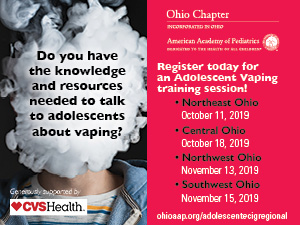
Paid sponsorship by Ohio Chapter, American Academy of Pediatrics
As you may know, the U.S. Surgeon General has referred to the current trends in adolescent vaping and e-cigarette use as an “epidemic.” You have likely heard of JUUL, one of the most popular vape pens on the market, that is a favorite of adolescents due to being easily concealed and a multitude of popular flavors like mango, mint, fruit, and crème. What you may not know is that new devices are consistently being developed and launching in the consumer market place. A recent article in the August edition of Pediatrics highlights a new, “flashy” tobacco device that may lead teens down a path to becoming lifelong smokers.
The companies that develop these products promote them as harm reduction devices for current adult smokers. In other words, the products are intended for an adult population who have been smoking for years and are using the products to transition to a less harmful habit. However, the products are easily accessible and highly attractive to teens. Almost all of the products contain highly addictive nicotine that can have profound and irreversible effects on an adolescent’s developing brain, in addition to containing harmful chemicals and giving off secondhand aerosol that is unsafe to breathe. Additionally, as Brian Jenssen, MD, FAAP, and an expert on tobacco and children’s health note, “No matter what form nicotine takes, it always connects people back to cigarettes.” Rather than being a pathway to quitting, evidence shows that it’s a clear pathway to long-term cigarette and tobacco use.
- 40% of 12th graders admitted to vaping at least once in 2018, according to a national survey.
- 30% of youth who use e-cigarettes start smoking cigarettes, cigars, or hookahs within six months.
We are learning that much of our messaging around the adverse health effects of e-cigarette use may fall on deaf ears with teens. Messaging that does seem to have an impact centers around tobacco company’s storied history of manipulation and targeted marketing. Additionally, simple but powerful messages can help convey important information to teens. Statements like “safer doesn’t mean safe” and “not cool to JUUL” can resonate with teens.
While we may feel helpless and overwhelmed to address this very serious and growing epidemic, there is a great deal pediatric providers can do to prevent use and protect children from e-cigarettes and tobacco. The American Academy of Pediatrics (AAP) supports prevention as the most effective way to protect our youth through bans on flavored products that appeal to children, a minimum legal age of 21 years to buy nicotine products, and parity with taxation on tobacco and all nicotine products.
- Friday, October 11, from 10 a.m. – 1 p.m. at Akron Children’s Hospital
- Friday, October 18, from 10 a.m. – 1 p.m. at Columbus Metropolitan Main Library
- Wednesday, November 13, from 7:30 a.m. – Noon at Toledo Children’s Hospital
- Friday, November 15, from 1 – 4 p.m. at Dayton Children’s Hospital
Space is limited, so register NOW!
Join our Smoke Free Families Quaity Improvement Learning Collaborative!
Transform your practice, earn MOC IV credit, and impact modifiable risk factors to promote long-term health and reduce infant mortality risk for your patients! Space is limited so register NOW!
Please contact Program Manager Kristen Fluitt for more information.




